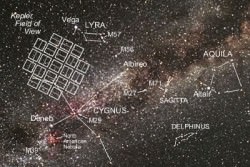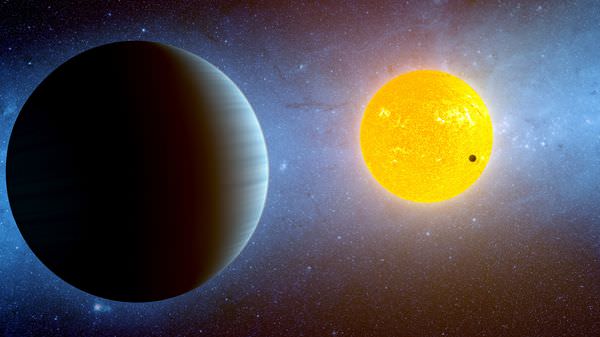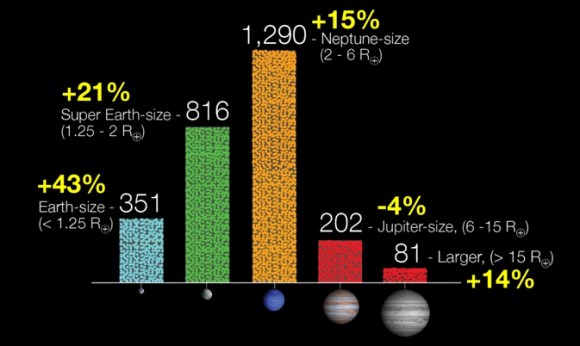Artist’s depiction of the Kepler 10 system, which contains planets 2.2 and 1.4 times the size of Earth. (NASA/Ames/JPL-Caltech)
Kepler mission scientists announced today the discovery of literally hundreds of new exoplanet candidates — 461, to be exact — orbiting distant stars within a relatively small cross-section of our galaxy, bringing the total number of potential planets awaiting confirmation to 2,740. What’s more, at least 4 of these new candidates appear to be fairly Earth-sized worlds located within their stars’ habitable zone, the orbital “sweet spot” where surface water could exist as a liquid.
Impressive results, considering that NASA’s planet-hunting spacecraft was launched a little under 4 years ago (and watching 150,000 stars to spot the shadows of planets is no easy task!)
“… the ways by which men arrive at knowledge of the celestial things are hardly less wonderful than the nature of these things themselves.”
— Johannes Kepler
Since the last official announcement of Kepler candidates in Feb. 2012 the number of smaller Earth- and super-Earth-sized worlds observed has risen considerably, as well as the identification of multi-planet systems that are organized more-or-less along a flat plane… just like ours.
“There is no better way to kickoff the start of the Kepler extended mission,” said Kepler scientist Christopher Burke, “than to discover more possible outposts on the frontier of potentially life bearing worlds.”
Read more: First Earth-Sized Exoplanets Found by Kepler
From the NASA press release:
Since the last Kepler catalog was released in February 2012, the number of candidates discovered in the Kepler data has increased by 20 percent and now totals 2,740 potential planets orbiting 2,036 stars. The most dramatic increases are seen in the number of Earth-size and super Earth-size candidates discovered, which grew by 43 and 21 percent respectively.
The new data increases the number of stars discovered to have more than one planet candidate from 365 to 467. Today, 43 percent of Kepler’s planet candidates are observed to have neighbor planets.
The most dramatic increases are seen in the number of Earth-size and super Earth-size candidates discovered, which grew by 43 and 21 percent respectively. (NASA)
Although some of the new candidates announced today are large Neptune-sized planets, more than half are Earth- to super-Earth sized worlds less than twice the radius of our own planet.
 In order for Kepler candidates to be “officially” called exoplanets, they must be observed 3 times on a regular orbit — that is, their signature dimming of the light from their home star must occur as predicted once their presence and then orbital period is calculated. Only then is an exoplanet confirmed.
In order for Kepler candidates to be “officially” called exoplanets, they must be observed 3 times on a regular orbit — that is, their signature dimming of the light from their home star must occur as predicted once their presence and then orbital period is calculated. Only then is an exoplanet confirmed.
To date Kepler has confirmed 105 exoplanets.
The longer the mission continues, the better the chance that Kepler will be able to confirm smaller Earth-sized worlds in longer-period orbits.
Read more: Kepler Mission Extended to 2016
“The analysis of increasingly longer time periods of Kepler data uncovers smaller planets in longer period orbits — orbital periods similar to Earth’s,” said Steve Howell, Kepler mission scientist. “It is no longer a question of will we find a true Earth analogue, but a question of when.”
Scientists analyzed more than 13,000 transit-like signals called ‘threshold crossing events’ to eliminate known spacecraft instrumentation and astrophysical false positives, phenomena that masquerade as planetary candidates, to identify the potential new planets. Watch the video below to see how Kepler observes the light-curve of transit events.
Read more on the NASA press release, and learn more about the Kepler mission here.



It is no longer a question of “Is there extraterrestrial life out there?” . . . . it is only a question of “When will we find it?”
But where is everybody?
The blog “Centauri Dreams” had recently some interesting comments on this question, far better than anything I could write. I can recommend the blog highly as lecture on this topic!
A few years ago we also had a question.
But where are the other planets?
And 10 years ago the question was: But where are the black holes?
Yes but planets and black holes can not send a message to us. Life could be common, but E.T is probably rare.
That seems to be a conflation between the astrobiological question (of biospheres) and the Fermi question (of communicable civilizations).
The first one is readily testable, and it is believed we will observe our first Earth analog this year and our first exobiosphere in a decade or two.
The second is readily observable (SETI) but perhaps not testable as the constraints are too wide. There are many unobservable pathways where civilizations never contact each other for some reason or other.
We should pursue both questions, but it is only the first that is likely to yield meaningful data.
Earth’s like the loser kids. 😀
When did the catalogue jump to 2,700 potential planets?! Last time I heard it was around 600! Thats a huge jump. (and here I was thinking I followed the exoplanet catalogue closely. Apparently not.)
Yeah, and it should be expected to shoot up even more, the next time the catalog is released. Can’t wait.
Figure of 600 has grown to about 850 and they are confirmed planets. While 2700 is potential planet candidates.
only a matter of time till we go to one. I personally think we should set off sooner rather than later. Having things just drift out of our solar system is a potential way of discovering life, but imagine if we sent something and found something on one of these planets.
The problem is the distances are incredibly large for today’s (and even tomorrow’s) technology.
Search for this to get an idea:
carl sagan planet walk hawaii
Only 147964 stars left to find planets around. Keep up the good work, Kepler!!!
Habitable planet for sale… best offer. Recently ‘sanitized’ with no troublesome megafauna or unwanted micro-organisms. Close in at only 15 light years away! Call the Garden of Earthly Delight’s at 777-867-5309 for details.
shouldnt be too long until breaking news is discovered, that will throw fireworks in every angle
Hope Kepler can be in service for as long as possible. At least until a new one comes to replace it.
The only photos of these exoplanets are no more than a pixel or two. I’m sure they exist but doubt the pseudo astro-physicists can actually determine much about their geology or climate as they claim.
Since you obviously don’t know the science you lament (those “pseudo” astrophysicists are well recognized by the science community), why do you think anyone would respond on your pseudoscience level?
Beyond that your two sentences are fractally wrong, and it would take too long to respond properly. If you are really interested in the science, you could start by reading the Wikipedia articles on exoplanet detection. They are quite good, and they enable you to state meaningful questions after you get rid of your miscomprehension of how it is done.
For an Earth-like planet to have complex biology and ecosystems I think it is important that it exist in a gravitational environment that permits a fairly stable orbit. I think this is an important criterion. for if the planet’s orbit is heavily perturbed by other planets it may migrate chaotically around or in and out of the habitable zone.
LC
Spores will likely tie the simpler, most common biospheres over.
Even crust habitability may tie complex, nematode like worms over. The lowest nematodes found to date has been found ~ 1 km down.
And ocean habitability (ice locked oceans) can preserve oceans much as we know them. (Cf hydrothermal vent life.)
To put this in perspective, there was a recent paper estimating the number of potential Kepler candidates. We can call that candidates for candidates.
In their estimate Kepler’s pipeline has ~ 18 000 candidates around ~ 11 000 stars! [ http://arxiv.org/pdf/1212.2915v1.pdf ] The pipeline is ~ 98 % accurate.
The current Kepler lower estimate of at least ~ 100 – 200 billion Milky Way planets can be orders of magnitude from the actual average value. Even the naive estimate from our system of 8 planets*200 billion stars of ~ 2 trillion planets can be low. As a comparison, if Kepler looked at 100 000 Suns. it would see only ~ 3-400 planets (most likely Venus at ~ 0.4 %, usually only one planet since our system is too wobbly to have more planets aligned).
The actual figure will depend sensitively on models of planet system formation.